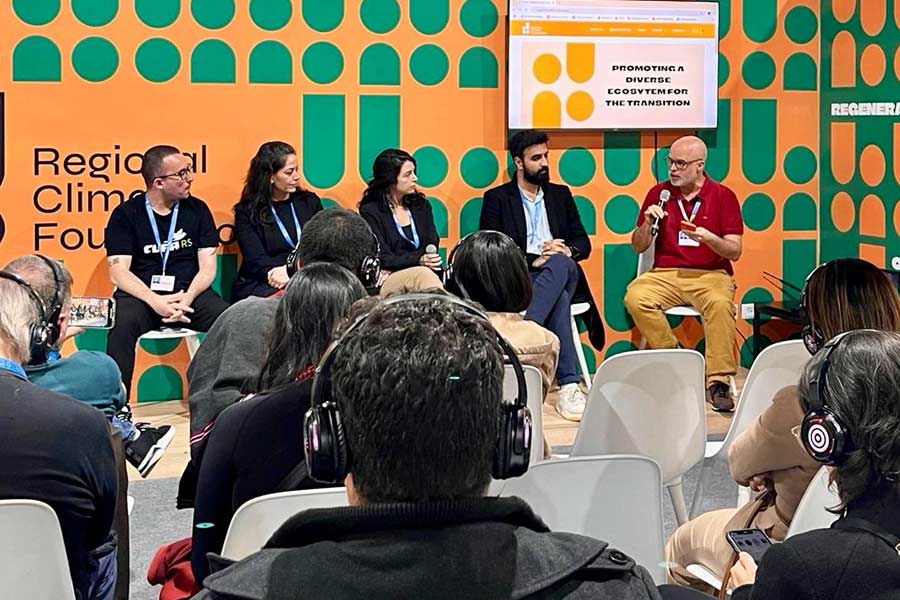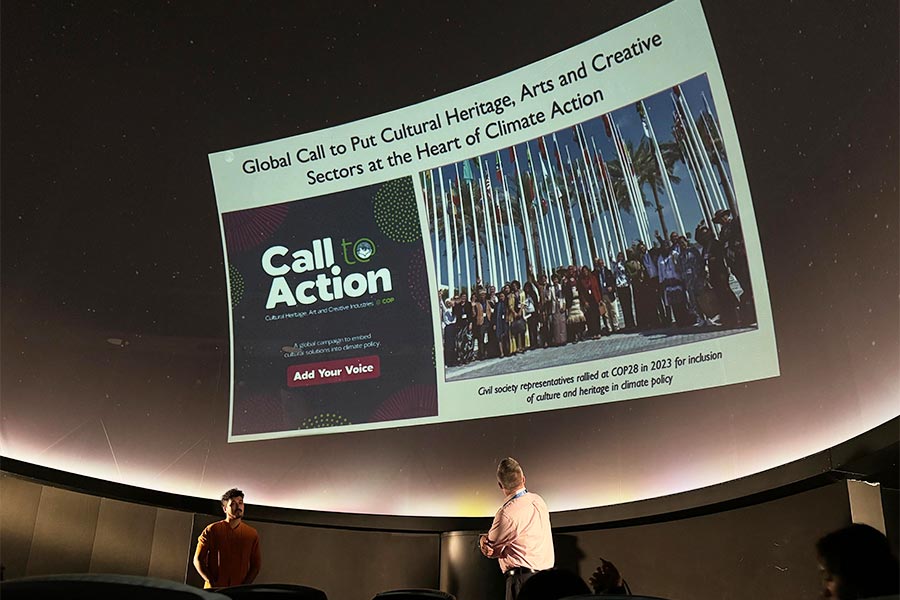I arrived for COP29 in Baku with a clear mission — to celebrate the transformative role of culture in addressing the climate crisis. I was there as part of the Creative Climate Leadership network, supported by Julie’s Bicycle and the European Cultural Foundation’s Culture of Solidarity Fund. Yet, no preparation could have readied me for the whirlwind of emotions, insights and connections I would experience. COP29 was not just a summit, it was a kaleidoscope of stories, a testament to the creativity, resilience and humanity at the heart of the climate movement.
Young volunteers tirelessly assisting delegates despite logistical gaps became the unsung heroes of the event
My journey began like many others at COP — with a crowded flight filled with a mix of delegates. At Istanbul’s SAW airport, the gate for my connecting flight to Baku reflected the diversity of the climate movement — activists sporting bold scarves, policymakers in suits, and academics and journalists with quiet resolve. Landing in Baku in the pre-dawn hours, my taxi driver, Anar, took me on an impromptu tour of the city, his humour and warmth transcending the language barrier. This ride wasn’t just a journey to my accommodation but my first connection to Baku, a city that would reveal itself as both a host and an integral part of the COP experience.
My first morning at COP was marked by an adventure. Determined to find my way to the Baku Stadium, the official venue, I sought shuttles or the metro but faced confusing directions and inaccessible signage. Left near a metro station, I asked for help — an exercise in patience. A chance meeting with the Ukrainian delegation led us to the shuttles, a moment underscoring the unspoken solidarity among attendees. Young volunteers tirelessly assisting delegates despite logistical gaps became the unsung heroes of the event, grounding an otherwise chaotic experience.
We explored how culture, communication and diverse ecosystems can drive a just and inclusive transition

The author (second from right) at the panel on ‘Promoting a Diverse Ecosystem for the Transition’
Storytelling was a recurring theme at COP29, vividly illustrated during the ‘Extreme Hangout’ panel on ‘Innovative Storytelling for Our Planet’. Led by Studio Birthplace co-founders, Sil van der Woerd and Jorik Dozy, their film Earth Defenders spotlighted the dangers faced by Amazonian defenders, eliciting both anger and admiration for their courage.
Later, the Palestinian Heritage and Culture Workshop brought cultural resilience to the forefront through the rhythm of dabke dancing, Palestinian music and henna art. These cultural expressions spoke of the importance of preserving identity alongside policy and action in the fight for climate justice. Another standout was the ECCA Film and TV Panel, which celebrated the Entertainment and Culture for Climate Action framework. Listening to committee members reinforced my belief in the transformative power of media in shaping climate narratives.
I had one of the most enriching experiences at COP29 by participating in the panel ‘Promoting a Diverse Ecosystem for the Transition’, organised by the Regional Climate Foundations. Together with Andrea Ramirez from Colombia, a researcher focusing on urban resilience; Junior Torres, a Brazilian grassroots leader advocating for marginalised communities; Sara Ramos de Avila, a Brazilian creative technologist reimagining storytelling through immersive realities; and Leonardo Menezes, a curator and audiovisual director championing cross-disciplinary collaboration, we explored how culture, communication and diverse ecosystems can drive a just and inclusive transition.
I shared my insights on the intersection of media, culture and climate justice, drawing from my experiences as a documentarian and media strategist. The panel highlighted the power of bringing together voices from across geographies and disciplines to foster creative solutions for systemic change. It was a powerful reminder of how collaboration is key to reshaping narratives and advancing climate action.
The Uzbekistan Pavilion stood out as a sanctuary amidst bustling venues

The hospitality and thoughtful storytelling at the Uzbekistan Pavilion exemplified the power of cultural narratives
A defining moment was the Culture Panel at the Azerbaijan Pavilion, where cultural leaders and Princess Dana Firas called for integrating culture into climate goals. The presence of Azerbaijan’s Culture Minister Adil Karimli and COP29 President Mukhtar Babayev was validating, yet the absence of formal recognition for culture within the broader climate discourse was sobering. The launch of the Culture and Climate Report by C de Cultura provided critical data to guide justice-focused policies. Delivering this report felt like a crucial step towards embedding culture in climate action.
The Goal House Event in Baku’s Old Town further celebrated cultural resilience. Youth leaders shared personal stories of their communities, embodying hope and determination. Similarly, the ECCA Pavilion event at the Tusi-Bohm Planetarium blended storytelling with immersive visuals, demonstrating how creative spaces can inspire meaningful dialogue.
The Uzbekistan Pavilion stood out as a sanctuary amidst bustling venues. Its serene design, involving water features and remnants of the dying Aral Sea, provided a reflective space. The hospitality and thoughtful storytelling exemplified the power of cultural narratives in climate advocacy. Meanwhile, the Brazilian Pavilion hinted at the promise of COP30 in Belem, showcasing indigenous leadership and resilience. For someone from the Himalayas, the Amazonian communities’ influence on global discussions was deeply inspiring.
The overpriced cost of food was another stark reminder of inequity

While COP29 offered moments of inspiration, it also exposed systemic challenges
COP29 brought together an extraordinary array of changemakers. Connecting with leaders like Vinicius Gurtler and Ursula Vidal, who are integrating cultural narratives into climate strategies for COP30, was inspiring. Young leaders like Samia Dumbuya, Zamzam Ibrahim, and Marina Gomes offered a glimpse into vibrant youth-driven initiatives shaping the future. These interactions reiterated the critical role of leadership rooted in empathy and collaboration.
While COP29 offered moments of inspiration, it also exposed systemic challenges. The Commonwealth Pavilion, though one of the few spaces with South Asian delegates and conversations, often felt mired in bureaucracy, reminiscent of an Indian government office. The absence of an Indian Pavilion, a glaring void given India’s rich cultural heritage, was disappointing.
The overpriced cost of food — 49 manats (Rs 2,500, approximately) for a basic meal — was another stark reminder of inequity. Delegates from the Global South, including youth activists, faced hard choices between stretching limited budgets and going hungry.
Personally, daily commutes with Alison Tickell and Anna Guyer, founders of Julie’s Bicycle and Greenhouse Communications, turned into deep dives into strategy and shared dreams. The vibrant streets of Baku’s Old Town, with their blend of Ottoman, Soviet and Central Asian influences, provided the perfect backdrop for reflection, grounding me in the resilience of cultures that withstand time and change.
A testament to culture’s capacity to heal, connect and drive action

As we look toward COP30 in Brazil, the stakes are higher, but so is the potential
As I left Baku after spending a week participating and attending COP29, I reflected on the second high-level ministerial meeting I attended, a promising step forward for culture-based climate action. Building on the foundation laid last year with the Group of Friends for Culture-Based Climate Action, this meeting brought together cultural ministries and civil society to strategise future steps. The Global Call — a mechanism to build momentum to make culture central to climate decision-making, is set to relaunch its public-facing campaign under Alison Tickell’s leadership, bridging gaps between policy and public engagement. It is a testament to the growing momentum behind culture’s role in the climate movement.
COP29 was a mosaic of human stories, a testament to culture’s capacity to heal, connect and drive action. As we look toward COP30 in Brazil, the stakes are higher, but so is the potential. The road ahead is daunting yet exhilarating, and I remain determined to advocate for a world where culture is not an afterthought but a cornerstone of climate action.
Syed Jazib Ali is a media strategist and the founder of the Amsterdam-based Mudland Studio. With a career rooted in storytelling, Jazib specialises in crafting narratives that challenge the status quo and drive social change.


